Summary
Glioblastoma multiforme (GBM) is the most common malignant tumor of the central nervous system (CNS). Effective treatments remain limited. Therefore, novel chemotherapy drugs with high efficiency and few adverse effects are urgently needed. Histone deacetylase (HDAC) and serum and glucocorticoid-regulated protein kinase 1 (SGK1) are targets for the prevention and treatment of GBM. Rhein has antitumor and SGK1 suppression effects, although its biological activity is limited by poor bioavailability. To improve the drug-like properties of rhein, we constructed a novel rhein-hydroxyethyl hydroxamic acid derivative (SYSUP007), which combined rhein with the HDAC inhibitor, suberoylanilide hydroxamic acid (SAHA). In the present study, the human GBM cell lines, T98G, U87 and U251, were used to investigate the anticancer effects of SYSUP007 in vitro. We found that SYSUP007 was more effective in inhibiting glioma cell proliferation, invasion and migration in vitro compared with the effects of rhein and SAHA. We also confirmed that SYSUP007 increased the expression of Ac-K100 and NDRG1 (targets of HDAC and SGK1). The present study indicates the potential that SYSUP007, as a novel rhein and SAHA derivative, for development as an anti-cancer therapy.








Similar content being viewed by others
References
Ostrom QT, Gittleman H, Liao P, Rouse C, Chen Y, Dowling J, Wolinsky Y, Kruchko C, Barnholtz-Sloan J (2014) CBTRUS Statistical Report: Primary Brain and Central Nervous System Tumors Diagnosed in the United States in 2007–2011. Neuro-Oncology 16 (suppl 4):iv1–63
Li H, Chen L, Li JJ, Zhou Q, Huang AN, Liu WW, Wang K, Gao L, Qi ST, Lu YT (2018) miR-519a enhances chemosensitivity and promotes autophagy in glioblastoma by targeting STAT3/Bcl2 signaling pathway. J Hematol Oncol 11. https://doi.org/10.1186/s13045-018-0618-0
Liu S, Tang Y, Yuan X, Yuan D, Liu J, Li B, Li Y (2018) Inhibition of Rb and mTOR signaling associates with synergistic anticancer effect of palbociclib and erlotinib in glioblastoma cells. Investig New Drugs 36(6):961–969. https://doi.org/10.1007/s10637-018-0575-z
Alex T, Atique A, Kyung-Sub M, Lesniak MS (2013) The art of gene therapy for glioma: a review of the challenging road to the bedside. J Neurol Neurosurg Psychiatry 84(4):326–326
Kibble M, Saarinen N, Tang J, Wennerberg K, Mäkelä S, Aittokallio T (2015) Network pharmacology applications to map the unexplored target space and therapeutic potential of natural products. Nat Prod Rep 32(8):1249–1266
He M, Luo M, Liu Q, Chen J, Li K, Zheng M, Weng Y, Ouyang L, Liu A (2016) Combination treatment with fasudil and clioquinol produces synergistic anti-tumor effects in U87 glioblastoma cells by activating apoptosis and autophagy. J Neuro-Oncol 127:261–270
Falkenberg KJ, Johnstone RW (2014) Histone deacetylases and their inhibitors in cancer, neurological diseases and immune disorders. Nat Rev Drug Discov 13(9):673–691
Shi XY, Ding W, Li TQ, Zhang YX, Zhao SC (2017) Histone Deacetylase (HDAC) Inhibitor, Suberoylanilide Hydroxamic Acid (SAHA), Induces Apoptosis in Prostate Cancer Cell Lines via the Akt/FOXO3a Signaling Pathway. Med Sci Monit 23:5793–5802. https://doi.org/10.12659/MSM.904597
Wang J, Yan WX, Li JT, Peng SB, Li J, Xiao HJ, Wen XQ (2016) Correlation between HDAC6 expression and clinical features of renal cell carcinoma. Int J Clin Exp Pathol 9(9):9364–9371
Peters KB, Lipp ES, Miller E, Herndon JE 2nd, McSherry F, Desjardins A, Reardon DA, Friedman HS (2018) Phase I/II trial of vorinostat, bevacizumab, and daily temozolomide for recurrent malignant gliomas. J Neuro-Oncol 137(2):349–356. https://doi.org/10.1007/s11060-017-2724-1
Moyal L, Goldfeiz N, Gorovitz B, Rephaeli A, Tal E, Tarasenko N, Nudelman A, Ziv Y, Hodak E (2018) AN-7, a butyric acid prodrug, sensitizes cutaneous T-cell lymphoma cell lines to doxorubicin via inhibition of DNA double strand breaks repair. Investig New Drugs 36(1):1–9. https://doi.org/10.1007/s10637-017-0500-x
Huang ZM, Peng SW, Knoff J, Lee SY, Yang B, Wu TC, Hung CF (2015) Combination of proteasome and HDAC inhibitor enhances HPV16 E7-specific CD8(+) T cell immune response and antitumor effects in a preclinical cervical cancer model. J Biomed Sci 22. https://doi.org/10.1186/s12929-014-0111-1
Pont LM, Naipal K, Kloezeman JJ, Venkatesan S, van den Bent M, van Gent DC, Dirven CM, Kanaar R, Lamfers ML, Leenstra S (2015) DNA damage response and anti-apoptotic proteins predict radiosensitization efficacy of HDAC inhibitors SAHA and LBH589 in patient-derived glioblastoma cells. Cancer Letters 356 (2 Pt B):525–535. https://doi.org/10.1016/j.canlet.2014.09.049
Qiu-He C, Rong-Biao P, Jing-Kao C (2016) Pharmacology of Rhein and Advancement in the Synthesis of Its Derivatives. Current Traditional Medicine 2(1):59–69. https://doi.org/10.2174/2215083802666160620131215
Wu L, Cao K, Ni Z, Wang S, Li W, Liu X, Chen Z (2018) Rhein reverses doxorubicin resistance in SMMC-7721 liver cancer cells by inhibiting energy metabolism and inducing mitochondrial permeability transition pore opening. BioFactors (Oxford, England):8. https://doi.org/10.1002/biof.1462
Zhang Q, Yin SS, Liu L, Liu ZH, Cao WS (2016) Rhein reversal of DNA hypermethylation-associated Klotho suppression ameliorates renal fibrosis in mice. Sci Rep:6. https://doi.org/10.1038/srep34597
Liu S, Wang J, Shao T, Song P, Kong Q, Hua H, Luo T, Jiang Y (2018) The natural agent rhein induces beta-catenin degradation and tumour growth arrest. J Cell Mol Med 22(1):589–599. https://doi.org/10.1111/jcmm.13346
Sun H, Luo G, Chen D, Xiang Z (2016) A Comprehensive and System Review for the Pharmacological Mechanism of Action of Rhein, an Active Anthraquinone Ingredient. Front Pharmacol 7:247. https://doi.org/10.3389/fphar.2016.00247
Li QH, Wen J, Yu KT, Shu Y, He WL, Chu HX, Zhang B, Ge C (2018) Aloe-emodin induces apoptosis in human oral squamous cell carcinoma SCC15 cells. BMC Complement Altern Med 18. https://doi.org/10.1186/s12906-018-2353-z
Castel P, Scaltriti M (2017) The emerging role of serum/glucocorticoid-regulated kinases in cancer. Cell Cycle 16(1):5–6. https://doi.org/10.1080/15384101.2016.1232071
Castel P, Ellis H, Bago R, Toska E, Razavi P, Carmona FJ, Kannan S, Verma CS, Dickler M, Chandarlapaty S, Brogi E, Alessi DR, Baselga J, Scaltriti M (2016) PDK1-SGK1 Signaling Sustains AKT-Independent mTORC1 Activation and Confers Resistance to PI3Kalpha Inhibition. Cancer Cell 30(2):229–242. https://doi.org/10.1016/j.ccell.2016.06.004
Talarico C, Dattilo V, D'Antona L, Barone A, Amodio N, Belviso S, Musumeci F, Abbruzzese C, Bianco C, Trapasso F, Schenone S, Alcaro S, Ortuso F, Florio T, Paggi MG, Perrotti N, Amato R (2016) SI113, a SGK1 inhibitor, potentiates the effects of radiotherapy, modulates the response to oxidative stress and induces cytotoxic autophagy in human glioblastoma multiforme cells. Oncotarget 7 (13):15868–15884. https://doi.org/10.18632/oncotarget.7520
Wang J, Liu S, Yin Y, Li M, Wang B, Yang L, Jiang Y (2015) FOXO3-mediated up-regulation of Bim contributes to rhein-induced cancer cell apoptosis. Apoptosis: an International J Programmed Cell Death 20(3):399–409. https://doi.org/10.1007/s10495-014-1071-3
Wu C, Cao H, Zhou H, Sun L, Xue J, Li J, Bian Y, Sun R, Dong S, Liu P, Sun M (2017) Research Progress on the Antitumor Effects of Rhein: Literature Review. Anti-Cancer Agents Medicinal Chemistry 17(12):1624–1632. https://doi.org/10.2174/1871520615666150930112631
Zheng SH, Huang JL, Chen M, Wang BL, Ou QS, Huang SY (2018) Diagnostic value of preoperative inflammatory markers in patients with glioma: a multicenter cohort study. J Neurosurg 129(3):583–592. https://doi.org/10.3171/2017.3.JNS161648
Yin XF, Zhang Q, Chen ZY, Wang HF, Li X, Wang HX, Li HX, Kang CM, Chu S, Li KF, Li Y, Qiu YR (2018) NLRP3 in human glioma is correlated with increased WHO grade, and regulates cellular proliferation, apoptosis and metastasis via epithelial-mesenchymal transition and the PTEN/AKT signaling pathway. Int J Oncol 53(3):973–986. https://doi.org/10.3892/ijo.2018.4480
Orlacchio A, Ranieri M, Brave M, Arciuch VA, Forde T, De Martino D, Anderson KE, Hawkins P, Di Cristofano A (2017) SGK1 Is a Critical Component of an AKT-Independent Pathway Essential for PI3K-Mediated Tumor Development and Maintenance. Cancer Res 77(24):6914–6926. https://doi.org/10.1158/0008-5472.can-17-2105
Marampon F, Leoni F, Mancini A, Pietrantoni I, Codenotti S, Letizia F, Megiorni F, Porro G, Galbiati E, Pozzi P, Mascagni P, Budillon A, Maggio R, Tombolini V, Fanzani A, Gravina GL, Festuccia C (2018) Histone deacetylase inhibitor ITF2357 (givinostat) reverts transformed phenotype and counteracts stemness in in vitro and in vivo models of human glioblastoma. J Cancer Research Clinical Oncology 1–17 https://doi.org/10.1007/s00432-018-2800-8
Zhou WJ, Chen XX, He K, Xiao JF, Duan XP, Huang R, Xia ZL, He JL, Zhang JQ, Xiang G (2016) Histone deacetylase inhibitor screening identifies HC toxin as the most effective in intrahepatic cholangiocarcinoma cells. Oncol Rep 35(5):2535–2542. https://doi.org/10.3892/or.2016.4636
Chen XC, Wei XT, Guan JH, Shu H, Chen D (2017) EGF stimulates glioblastoma metastasis by induction of matrix metalloproteinase-9 in an EGFR-dependent mechanism. Oncotarget 8(39):65969–65982. https://doi.org/10.18632/oncotarget.19622
Lin ZW, Wang Z, Li GB, Li BW, Xie WL, Xiang DC (2016) Fibulin-3 may improve vascular health through inhibition of MMP-2/9 and oxidative stress in spontaneously hypertensive rats. Mol Med Rep 13(5):3805–3812. https://doi.org/10.3892/mmr.2016.5036
Weiler M, Blaes J, Pusch S, Sahm F, Czabanka M, Luger S, Bunse L, Solecki G, Eichwald V, Jugold M, Hodecker S, Osswald M, Meisner C, Hielscher T, Rubmann P, Pfenning PN, Ronellenfitsch M, Kempf T, Schnolzer M, Abdollahi A, Lang F, Bendszus M, von Deimling A, Winkler F, Weller M, Vajkoczy P, Platten M, Wick W (2014) mTOR target NDRG1 confers MGMT-dependent resistance to alkylating chemotherapy. Proc Natl Acad Sci U S A 111 (1):409–414. https://doi.org/10.1073/pnas.1314469111
Chen X, Chen Q, Yalin TU, Rongbiao PI (2016) New progress of serum and glucocorticoid-inducible kinase 1 on CNS diseases. J Pharm Res 35:559–569
Kulkarni S, Goel-Bhattacharya S, Sengupta S, Cochran BH (2018) A Large-Scale RNAi Screen Identifies SGK1 as a Key Survival Kinase for GBM Stem Cells. Molecular Cancer Research : MCR 16(1):103–114. https://doi.org/10.1158/1541-7786.mcr-17-0146
Wang X, Wang F, Zhang X, Rheumatology DO (2013) Rhein attenuates renal fibrosis through reducing the expression of serum and glucocorticoid-induced protein kinase in diabetic rats. J Binzhou Medical University 36:253
Hu ZY, Xie WB, Yang F, Xiao LW, Wang XY, Chen SY, Li ZG (2015) NDRG1 attenuates epithelial-mesenchymal transition of nasopharyngeal cancer cells via blocking Smad2 signaling. Biochim Biophys Acta-Mol Basis Dis 1852(9):1876–1886. https://doi.org/10.1016/j.bbadis.2015.06.009
Funding
This study was supported by grants to R. Pi from Guangdong Provincial International Cooperation Project of Science & Technology (No. 2013B051000038), The National Natural Science Foundation of China (No. 31371070 and 81671264) and the Fundamental Research Funds for the Central Universities (No. 15ykjc08b) and a grant to J. Chen from The National Natural Science Foundation of China (No. 81703539).
Author information
Authors and Affiliations
Corresponding author
Ethics declarations
Conflict of interest
All authors declare that they have no conflicts of interest.
Ethical approval
This article does not contain any studies with human participants or animals performed by any of the authors.
Informed consent
For this type of study, formal consent is not required.
Additional information
Publisher’s note
Springer Nature remains neutral with regard to jurisdictional claims in published maps and institutional affiliations.
Rights and permissions
About this article
Cite this article
Chen, J., Luo, B., Wen, S. et al. Discovery of a novel rhein-SAHA hybrid as a multi-targeted anti-glioblastoma drug. Invest New Drugs 38, 755–764 (2020). https://doi.org/10.1007/s10637-019-00821-4
Received:
Accepted:
Published:
Issue Date:
DOI: https://doi.org/10.1007/s10637-019-00821-4




